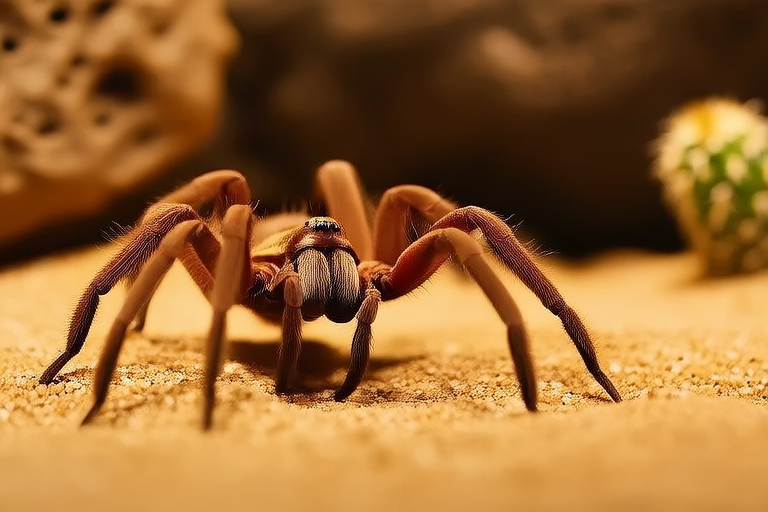
The Ultimate Guide: How to Care for a Chilean Rose Tarantula Like a Pro
Introduction
Welcome to the comprehensive guide on how to care for a Chilean Rose Tarantula like a pro. Whether you’re a first-time owner or an experienced arachnid enthusiast, this guide will provide you with all the necessary information to ensure your pet’s well-being. We’ll cover everything from setting up the perfect habitat to understanding their dietary needs and common health issues.
Habitat Setup
Creating the right environment for your Chilean Rose Tarantula (Grammostola rosea) is crucial for its health and happiness. Start by selecting an appropriate enclosure, ideally a glass tank with a secure lid to prevent escapes. The size of the tank should be proportional to the tarantula’s size; a general rule is to provide at least three times the leg span in height and length.
Substrate is another important consideration. Use a bedding material that retains moisture but allows for burrowing, such as coconut fiber or a mix of peat moss and vermiculite. A depth of around 3 inches is suitable, ensuring that it can dig and create a comfortable retreat.
Incorporate hiding spots and climbing structures into the enclosure. This can include cork bark, half logs, or artificial plants. These items provide security and stimulate natural behaviors. Ensure there are no sharp edges or small parts that could harm your tarantula.
Temperature and Humidity Requirements
Maintaining optimal temperature and humidity levels is vital for the health of your Chilean Rose Tarantula. These creatures thrive in temperatures between 75°F and 85°F (24°C to 29°C). Use a thermometer to monitor the ambient temperature within the enclosure. Heat sources, such as under-tank heaters or ceramic heat emitters, can be used to maintain these conditions.
Humidity should range between 60% and 80%. To achieve this, mist the substrate occasionally and provide a shallow water dish. However, avoid over-saturating the enclosure as excessive moisture can lead to respiratory issues and mold growth.
Diet Specifics
Chilean Rose Tarantulas are opportunistic feeders that consume a variety of prey. In captivity, they can be fed appropriately sized insects such as crickets, mealworms, and dubia roaches. Feed them once or twice a week, depending on their age and size. Juveniles require more frequent feeding compared to adults.
Ensure that the prey item is not larger than the width of the tarantula’s abdomen. Gut-load the feeder insects with nutritious foods before offering them to your tarantula. This practice enhances the nutritional value of the prey, benefiting your pet’s overall health.
Varying the diet can also contribute to better nutrition. Introduce occasional supplements like calcium powder or cricket powder to enrich the meal. Always remove uneaten prey after 24 hours to prevent potential harm to your tarantula.
Handling Tips
While handling your Chilean Rose Tarantula can be rewarding, it requires caution and respect for their natural behavior. These tarantulas are generally docile, but mishandling can cause stress or injury. Here are some tips:
- Prepare the Environment: Ensure the room is quiet and free from distractions. Have a secure container ready to place the tarantula in if needed.
- Use Gloves: Some handlers prefer to wear gloves to protect themselves from accidental bites and to provide better grip.
- Pick Up Gently: Approach the tarantula slowly and gently scoop it up from behind. Avoid touching its legs directly.
- Avoid Frequent Handling: Limit handling sessions to minimize stress. Frequent handling can disrupt their natural behavior and routine.
Health Issues to Watch For
Regular observation of your tarantula’s behavior and physical condition is key to early detection of potential health issues. Look out for the following signs:
- Lethargy: Unusual lack of activity or interest in food may indicate illness.
- Abnormal Movements: Clumsiness, difficulty moving, or loss of coordination can signal neurological problems.
- Wounds or Blemishes: Any visible injuries, discoloration, or abnormal growths warrant immediate attention.
- Respiratory Distress: Rapid breathing, open mouth, or labored breathing might indicate respiratory issues.
If you notice any of these symptoms, consult a veterinarian specializing in exotic animals for proper diagnosis and treatment.
Common Myths Debunked
There are several misconceptions surrounding Chilean Rose Tarantulas. Let’s address some of the most common ones:
- Myth: Tarantulas are aggressive and dangerous. While all tarantulas have venom, their bites are typically not life-threatening to humans. They prefer to flee rather than fight.
- Myth: Tarantulas need constant interaction. These creatures are solitary and nocturnal, requiring minimal human interaction. Excessive handling can stress them out.
- Myth: Tarantulas don’t need water. Providing a shallow water dish is essential for hydration and maintaining proper humidity levels.
- Myth: Tarantulas grow forever. Once they reach adulthood, their growth slows down significantly. Their lifespan ranges from 8 to 15 years.
Conclusion
Caring for a Chilean Rose Tarantula is a rewarding experience that requires dedication and knowledge. By following the guidelines outlined in this ultimate guide, you’ll be able to provide your pet with a healthy and happy environment. Remember to regularly observe your tarantula, maintain appropriate living conditions, and seek professional advice when necessary. Enjoy the unique bond you share with one of nature’s fascinating creatures.




